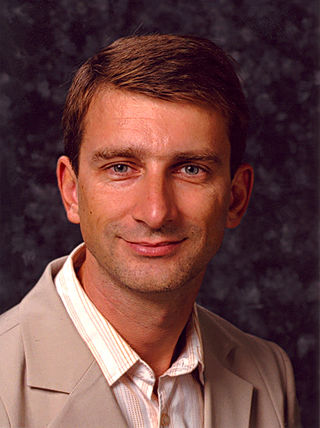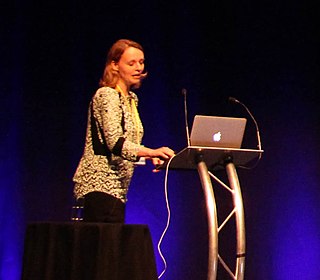
The Big Bang is a physical theory that describes how the universe expanded from an initial state of high density and temperature. The notion of an expanding universe was first scientifically originated by physicist Alexander Friedmann in 1922 with the mathematical derivation of the Friedmann equations. The earliest empirical observation of the notion of an expanding universe is known as Hubble's law, published in work by physicist Edwin Hubble in 1929, which discerned that galaxies are moving away from Earth at a rate that accelerates proportionally with distance. Independent of Friedmann's work, and independent of Hubble's observations, physicist Georges Lemaître proposed that the universe emerged from a "primeval atom" in 1931, introducing the modern notion of the Big Bang.

The cosmic microwave background, or relic radiation, is microwave radiation that fills all space in the observable universe. With a standard optical telescope, the background space between stars and galaxies is almost completely dark. However, a sufficiently sensitive radio telescope detects a faint background glow that is almost uniform and is not associated with any star, galaxy, or other object. This glow is strongest in the microwave region of the electromagnetic spectrum. The accidental discovery of the CMB in 1965 by American radio astronomers Arno Penzias and Robert Wilson was the culmination of work initiated in the 1940s.

Rainer "Rai" Weiss is a German-born American physicist, known for his contributions in gravitational physics and astrophysics. He is a professor of physics emeritus at MIT and an adjunct professor at LSU. He is best known for inventing the laser interferometric technique which is the basic operation of LIGO. He was Chair of the COBE Science Working Group.

Rashid Alievich Sunyaev is a German, Soviet, and Russian astrophysicist of Tatar descent. He got his MS degree from the Moscow Institute of Physics and Technology (MIPT) in 1966. He became a professor at MIPT in 1974. Sunyaev was the head of the High Energy Astrophysics Department of the Russian Academy of Sciences, and has been chief scientist of the Academy's Space Research Institute since 1992. He has also been a director of the Max Planck Institute for Astrophysics in Garching, Germany since 1996, and Maureen and John Hendricks Distinguished Visiting Professor in the School of Natural Sciences at the Institute for Advanced Study in Princeton since 2010. In February 2022, he signed an open letter from Russian scientists and science journalists condemning Russia's invasion of Ukraine.
Primordial fluctuations are density variations in the early universe which are considered the seeds of all structure in the universe. Currently, the most widely accepted explanation for their origin is in the context of cosmic inflation. According to the inflationary paradigm, the exponential growth of the scale factor during inflation caused quantum fluctuations of the inflaton field to be stretched to macroscopic scales, and, upon leaving the horizon, to "freeze in". At the later stages of radiation- and matter-domination, these fluctuations re-entered the horizon, and thus set the initial conditions for structure formation.

Planck was a space observatory operated by the European Space Agency (ESA) from 2009 to 2013. It was an ambitious project that aimed to map the anisotropies of the cosmic microwave background (CMB) at microwave and infrared frequencies, with high sensitivity and angular resolution. The mission was highly successful and substantially improved upon observations made by the NASA Wilkinson Microwave Anisotropy Probe (WMAP).

Charles L. Bennett is an American observational astrophysicist. He is a Bloomberg Distinguished Professor, the Alumni Centennial Professor of Physics and Astronomy and a Gilman Scholar at Johns Hopkins University. He is the Principal Investigator of NASA's highly successful Wilkinson Microwave Anisotropy Probe (WMAP).
Edward L. (Ned) Wright is an American astrophysicist and cosmologist. He has worked on space missions including the Cosmic Background Explorer (COBE), Wide-field Infrared Survey Explorer (WISE), and Wilkinson Microwave Anisotropy Probe (WMAP) projects.
Richard Massey is a physicist currently working as Royal Society Research Fellow in the Institute for Computational Cosmology at Durham University. Previously he was a senior research fellow in astrophysics at the California Institute of Technology and STFC Advanced Fellow at the Institute for Astronomy of the University of Edinburgh. Massey graduated in Maths and Physics from the University of Durham in 2000 and was a member of Castle. He completed his Ph.D. at Cambridge in 2003, with a thesis entitled Weighing the Universe with weak gravitational lensing.

Lyman Alexander Page, Jr. is the James S. McDonnell Distinguished University Professor of Physics at Princeton University. He is an expert in observational cosmology and one of the original co-investigators for the Wilkinson Microwave Anisotropy Probe (WMAP) project that made precise observations of the electromagnetic radiation from the Big Bang, known as cosmic microwave background radiation.
The Gruber Prize in Cosmology, established in 2000, is one of three prestigious international awards worth US$500,000 awarded by the Gruber Foundation, a non-profit organization based at Yale University in New Haven, Connecticut.

The CMB Cold Spot or WMAP Cold Spot is a region of the sky seen in microwaves that has been found to be unusually large and cold relative to the expected properties of the cosmic microwave background radiation (CMBR). The "Cold Spot" is approximately 70 μK (0.00007 K) colder than the average CMB temperature, whereas the root mean square of typical temperature variations is only 18 μK. At some points, the "cold spot" is 140 μK colder than the average CMB temperature.

Uroš Seljak is a Slovenian cosmologist and a professor of astronomy and physics at University of California, Berkeley. He is particularly well-known for his research in cosmology and approximate Bayesian statistical methods.
Marc Kamionkowski is an American theoretical physicist and currently the William R. Kenan, Jr. Professor of Physics and Astronomy at Johns Hopkins University. His research interests include particle physics, dark matter, inflation, the cosmic microwave background and gravitational waves.

Licia Verde is an Italian cosmologist and theoretical physicist and currently ICREA Professor of Physics and Astronomy at the University of Barcelona. Her research interests include large-scale structure, dark matter, dark energy, inflation and the cosmic microwave background.
Michele Limon is an Italian research scientist at the University of Pennsylvania. Limon studied physics at the Università degli Studi di Milano in Milan, Italy and completed his post-doctoral work at the University of California, Berkeley. He has been conducting research for more than 30 years and has experience in the design of ground, balloon and space-based instrumentation. His academic specialties include Astrophysics, Cosmology, Instrumentation Development, and Cryogenics.
Rachel Bean is a cosmologist, theoretical astrophysicist, professor of astronomy, and senior associate dean for math and science at the College of Arts and Sciences at Cornell University.
The Fred Hoyle Medal and Prize was established in 2008 by the Institute of Physics of London for distinguished contributions to astrophysics, gravitational physics or cosmology. The medal is named after astronomer Fred Hoyle who formulated the theory of stellar nucleosynthesis. The medal is made of silver and accompanied by a prize and a certificate. The medal was awarded biennially from 2008 to 2016. It has been awarded annually since 2017.

Joanna Dunkley is a British astrophysicist and Professor of Physics at Princeton University. She works on the origin of the Universe and the Cosmic microwave background (CMB) using the Atacama Cosmology Telescope, the Simons Observatory and the Large Synoptic Survey Telescope (LSST).

Erminia Calabrese, FLSW, is a Professor of Astronomy and the Director of Research at Cardiff University School of Physics and Astronomy. She works in observational cosmology using the cosmic microwave background radiation to understand the origins and evolution of the universe. In 2024 she became a Fellow of the Learned Society of Wales, and in 2022 she was awarded the Institute of Physics Fred Hoyle medal and the Learned Society of Wales Dillwyn medal.













